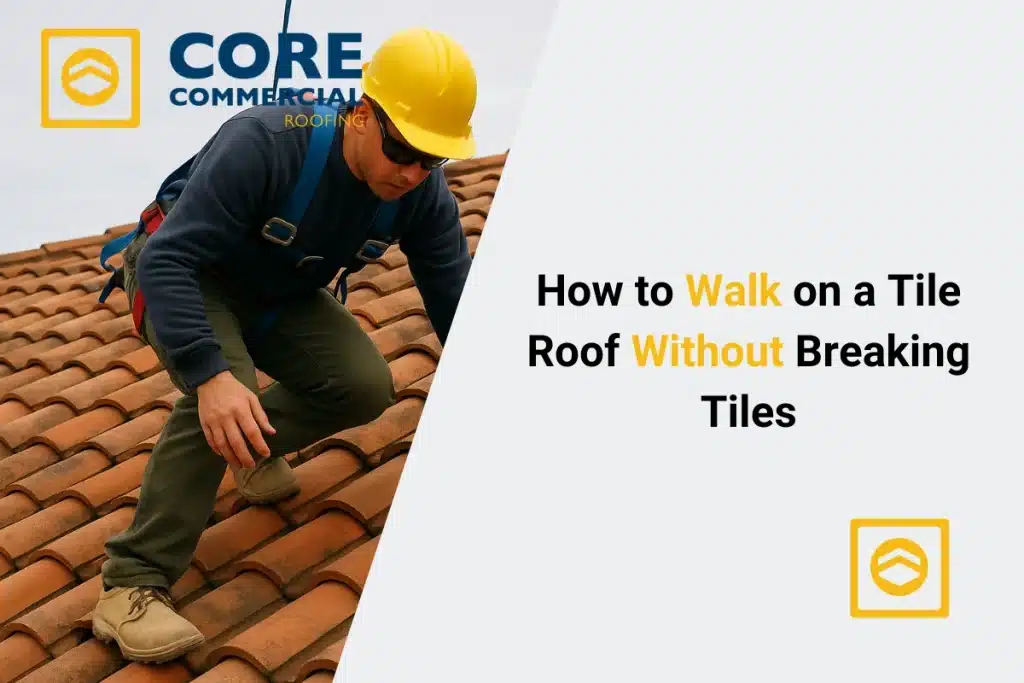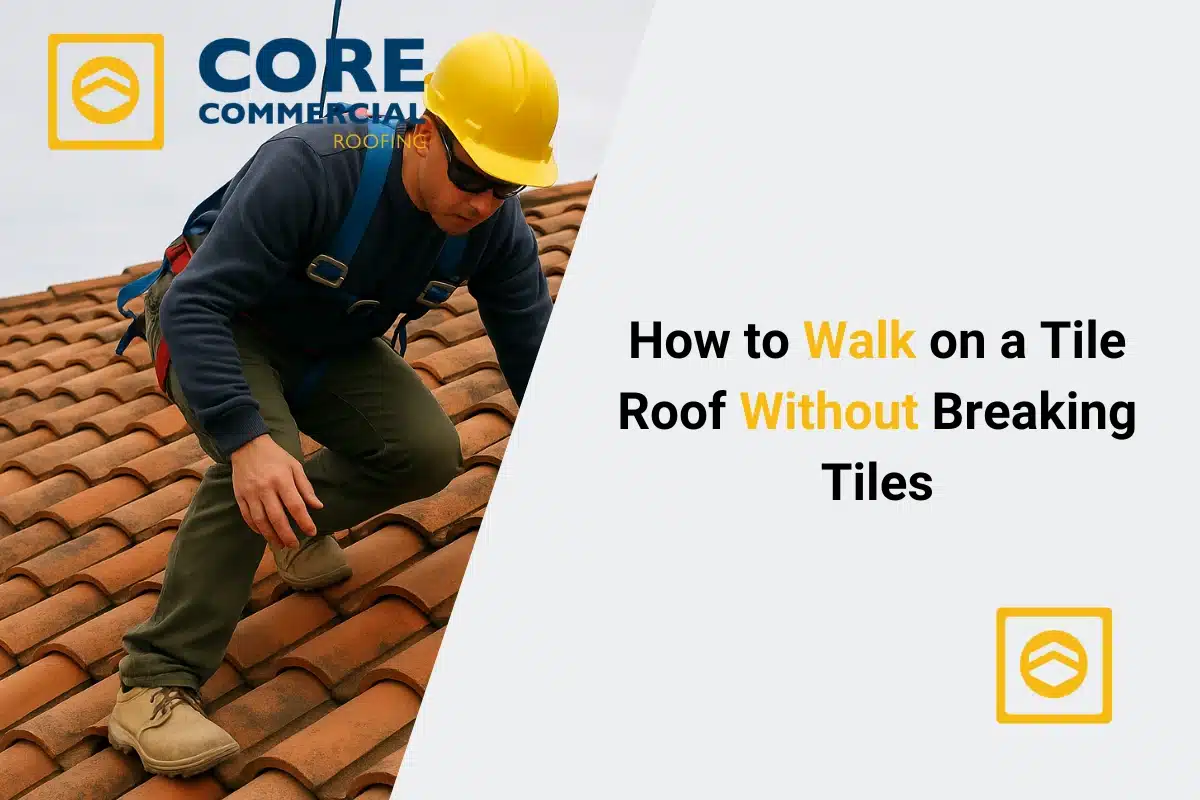Tile roofs are beautiful, durable, and long-lasting, but walking on them the wrong way can cause expensive damage. Whether you’re inspecting your roof, cleaning gutters, or installing equipment like solar panels, knowing how to walk safely on tile is critical. This guide breaks down everything homeowners and contractors need to know to protect both the roof and themselves. From understanding tile types to step-by-step walking techniques and common mistakes to avoid, we’ll help you walk safely and confidently on tile roofing—without cracking a single tile.

Table of Contents
Understanding the Structure of a Tile Roof
Before setting foot on your tile roof, it’s important to understand how it’s built. Most tile roofs use either concrete or clay tiles that rest on top of a waterproof underlayment. These tiles are not structural—they’re essentially a shell protecting what lies beneath.
- Concrete tiles are heavier and more durable, but still vulnerable to cracking under pressure.
- Clay tiles are lighter and more fragile, often used for aesthetic purposes on Mediterranean-style homes.
Underneath the tiles is a framework of battens and decking that supports weight, but the tiles themselves can snap if you step in the wrong spot.
Read now: commercial cool roofing
Why It’s Easy to Break Roof Tiles by Walking
People often assume tile is strong because it’s used on roofs, but these tiles are not designed to support direct foot traffic. Here’s why walking carelessly on tile can break it:
- Point Pressure: Your body weight is concentrated in small areas (your feet), putting stress on narrow parts of the tile.
- Unsupported Edges: Walking on the edges of tiles applies pressure where they’re most vulnerable.
- Hairline Cracks: Even light foot traffic can create cracks you won’t notice until it rains and your ceiling starts to leak.
Reasons You May Need to Walk on Your Roof
There are several practical reasons people need to access their tile roof:
- Gutter cleaning
- Chimney inspections
- Solar panel installation
- Pest control
- Moss removal
- Roof leak inspection
The key is learning how to do it safely and correctly.
Best Practices: How to Walk on a Tile Roof Without Damaging It
1. Choose the Right Shoes
Footwear is critical. Wear soft-soled, rubber-bottom shoes with a good grip. Avoid boots with deep treads or hard soles, which can crack tiles.
2. Avoid Walking if You Don’t Need To
Whenever possible, use tools like telescoping poles or drones to inspect the roof. If you must walk, plan your path and stick to it.
3. Step on the Bottom 3rd of the Tile
Always step where the tile overlaps the tile below it. This is the strongest part of the tile and most directly supported by the roof structure.
4. Walk Along the Rafters
Use a stud finder or check from the attic to locate where rafters support the roof. Walk along these lines to minimize pressure on unsupported sections.
5. Distribute Your Weight
Walk slowly and flat-footed. Keep your weight balanced and avoid putting all your weight on one foot.
6. Don’t Rush
Speed leads to missteps. Go slow, look where you’re stepping, and pause if necessary.
7. Use Safety Equipment
Always use a safety harness when working on a roof. A fall can result in severe injury or death, even from a single-story roof.
You may read: commercial roof inspection
How Professionals Do It: Pro Tips That Reduce Risk
Professionals in roofing and solar installation have methods that reduce risk even further:
- Use a Roof Ladder: Special ladders rest on the roof surface and spread out your weight to avoid breaking tiles.
- Use Foam Pads or Planks: Distribute weight over multiple tiles with foam mats or planks for walking or kneeling.
- Work from Scaffolding When Possible: If only part of the roof needs access, set up exterior scaffolding to reach from the edge.
Common Mistakes That Lead to Broken Roof Tiles
Avoid these errors, which often lead to broken tiles and expensive repairs:
- Wearing boots with hard soles
- Stepping on the top or middle of a tile instead of the bottom third
- Dragging tools or equipment across the surface
- Walking during hot or freezing conditions, which makes tiles more brittle
- Ignoring underlayment damage if a tile cracks
What to Do If You Break a Tile by Accident
Even with the best precautions, accidents happen. If you notice a cracked tile:
- Don’t leave it alone—water can seep through cracks and damage the underlayment.
- Cover the crack temporarily with roofing tape or sealant.
- Call a roofer for a professional repair or tile replacement.
- Check inside the attic after the next rain to make sure no water got through.
How to Spot Damage After Walking on the Roof
Sometimes you won’t see damage immediately. Here’s what to look for:
- Hairline cracks near the edges or corners of tiles
- Loose or rocking tiles that have shifted
- Discoloration or wet spots on the ceiling after rain
- Small leaks during heavy weather
Use binoculars from the ground or a drone for safer inspection.
Tile Roof Safety Considerations
Safety should be your first concern anytime you work on a roof. In addition to a safety harness, consider these:
- Only go up when the roof is dry and the weather is clear.
- Avoid working alone—have someone nearby in case of an emergency.
- Use roof anchors and ropes if you’re going to be on the roof for a long time.
- Always notify someone that you’re climbing up and check in when you’re done.
When You Shouldn’t Walk on a Tile Roof At All
There are times when it’s best to stay off the roof completely:
- If the tiles are old, brittle, or flaking
- If it’s raining or has recently rained
- If you’re unsure of your balance or physical ability
- If the slope of the roof is steep and not walkable
In these cases, hire a professional. It may cost a little more, but it could save thousands in repair and injury costs.
How to Maintain a Tile Roof Without Walking on It
If you’re looking to protect your roof long-term without stepping on it:
- Use a leaf blower with an extension wand to clear debris.
- Install gutter guards to minimize cleaning needs.
- Use a drone camera for visual inspections.
- Trim back tree branches to keep leaves and critters off the roof.
Preventive maintenance is always cheaper than fixing broken tiles and water damage.
Costs of Tile Roof Damage from Walking Incorrectly
Walking the wrong way on a tile roof doesn’t just crack a few tiles—it can lead to:
- Water leaks and ceiling stains
- Mold and mildew buildup
- Underlayment damage requiring full roof sections to be redone
- Structural rot in decking or rafters
- Repairs ranging from $300 to over $5,000, depending on the damage
Final Thoughts: Walk Carefully or Don’t Walk at All
Walking on a tile roof without breaking tiles is possible—but only with the right approach. By taking your time, wearing the right gear, and knowing exactly where and how to step, you can protect your home and avoid costly repairs. If in doubt, leave the job to professionals with the right tools and training.
FAQs
How do I walk on a tile roof without breaking tiles?
Walk only on the bottom third where tiles overlap, using soft‑soled shoes. Keep weight balanced, move slowly, and avoid edges or wet tiles to protect from cracking.
Best shoes for walking on tile roofs?
Use soft‑soled, rubber‑tread shoes with good grip, like sneakers. Hard boots or deep treads concentrate pressure and can crack or scratch tiles.
Can a homeowner inspect a tile roof safely?
Yes—if you step carefully on supported tiles, wear proper footwear, walk slowly, and use tools like roof ladders, foam pads, or drones.
Should I avoid walking on wet tile roofs?
Absolutely. Wet tiles are slippery and more likely to crack. Always wait 1–2 days after rain until tiles are fully dry.
Where is the safest place to step on a tile roof?
Step on the bottom third, where it overlaps the tile below and has full support underneath. Avoid ridges, valleys, and unsupported edges.
How to distribute weight on clay roof tiles?
Shift weight between feet and step flat‑footed. Use foam pads, roof ladders or walking boards to spread your weight across multiple tiles.
What if I accidentally crack a roof tile?
Stop walking, cover the crack temporarily with tape or sealant, then replace the tile ASAP to prevent leaks and underlayment damage.
Is it worth using crawling boards on a tile roof?
Yes, crawling boards or roof ladders spread your weight across tiles and greatly reduce cracking risk compared to stepping directly.
What safety gear is needed for tile roof work?
Wear soft‑soled shoes, gloves, a helmet, and a safety harness attached to an anchor. Never work on a steep or slippery roof alone.
How often should I inspect the tile roof?
Inspect once or twice a year—use binoculars or drones for dry-weather checks of cracks, dislodged tiles, or signs of wear before walking on it.






